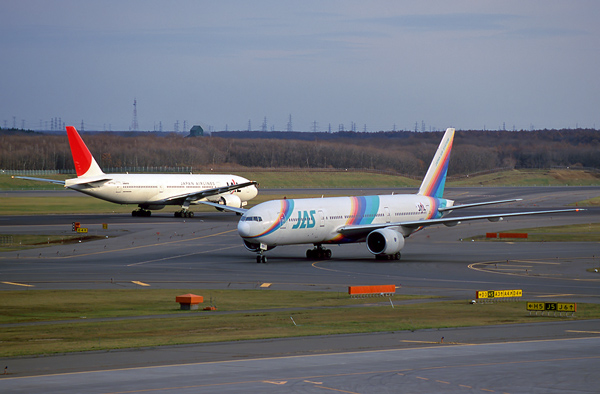The final chapter
The 21st century obviously did not start with a lot of prosperity for civil aviation, especially not in the areas of international and intercontinental passenger transport. Japanese carriers aditionally faced new financial challenges on the domestic market, as the criteria for approval to start an airline company were lowered considerably and tariffs were practically let loose in 2000. This resulted in quite a number of newcomers in the business, greatly increasing competition, and a gigantic fare reduction system. Some sources report 90% of all passengers are travelling on a ticket purchased with some sort of reduction.
As soon as the effects of September 11 started to diminish new dark clouds filled the sky in the form of the war in Iraq, SARS and the bird plague. In line with all of this, the business plan presented by JAL on March 10, 2004 announced projected cost savings of no less than 230 million euros (¥ 31 billion) in 2005. This will result in the loss of 4500 jobs, mostly concerning ground personnel. Clearly, the psychological effect on passengers of air travel's alleged dangers played a major role in the unavoidable reorganisation and fusion of JAS and JAL.
After more than fourty years the new JAL - Japan Airlines (Nihon Koku) abandoned the round crane logo, simultaneously symbolising the rising sun, as its icon. The new mark is the 'Arc of the Sun' in red and silver, depicted over the black printed 'JAL'. This logo is applied to the airplane's fuselages and the same arc is on the vertical stabilisers, but there the sun continues upwards and covers about half the tailfin. As can be expected this theme is repeated on winglets. Once again red has been the colour of choice. It is the national colour of Japan and the JAL management deems it appropriate to symbolize the two main concepts of Skyward Dreams and joy. The colour siver stands for professionalism, quality and innovation and black represents reliability and versatility. However, although the stylized capitals and coloured bands are in line with the JAS logo as it was, this will not make up for the loss of the original Rainbow colour schemes.
Nihon Air Commuter and Hokkaido Air System are also in the big stream that is taking everything to the new JAL group. Several Saabs are already flying in the new livery and the DHC-8-400 can be seen in the latest outfit as well. In these cases the applied titles are saying 'Japan Air Commuter' or 'Hokkaido Air System' though and HAC even has a logo formed by these capitals and the arc of the sun. Delivery of the Dash 8Q to JAC started during the JAS-JAL merger in October, 2002 and obviously this long and fast turboprop is to replace the YS-11.
[1] Noted in new JAL Group colours with own titles.
DHC-8-402 |
|||
| 4072 | JA841C | 10oct02 | JAC |
| 4073 | JA842C | 03dec02 | JAC |
| 4076 | JA843C | 03oct03 | JAC [1] dec03 |
Harlequin's MD-81 has only been given logos of the new Japan Airlines so far. Incidentally, that is the interim solution for all airplanes flying with the new group and still wearing JAS-colours: applying the new logo on a furter unchanged livery. Apart from the 777s it will remain easy to see which aircraft were operated by JAS even in the future, just by looking at the types: faithful Boeing customer JAL did not have any Airbus or MD-81/87/90 in its fleet.
The 30st anniversary of TDA/JAS on 15 May, 2001 was celebrated the appropriate way for Nihon Air System : A300 JA8472 (163) got its fuselage covered in children's drawings on the 'Friendly Bird' theme. The tailfin was painted dark blue with 'JAS' horizontally in white and above that was an image of the earth, looked at from high above the Pacific Ocean. Derived of the Japanese writing and with an all-blue tail this Airbus full of birds has visited Amsterdam-Schiphol on several occasions since its acquisition by Fly Air in spring 2003. It will take some time to repaint the whole Japan Air System fleet, leaving still a chance for those who would like to marvel at the rainbow colour schemes before they are gone. Despite all economic motives - and economics are what companies are all about - it will be a sad day when the last of the Rainbows has vanished from Japanese airports. Let us hope there will be enough new special colour schemes to bring a cheerful look.
The integration of JAS into JAL is the first of its kind in Japan since Toa Domestic Airlines was formed in 1971. The company, created by a long series of mergers going back fourty years, also practically vanished as the result of a merger. In Japan, a country full of symbolism and deeper meanings, this probably just had to be.

Coming and going. Carrying the New JAL Group logo on the rear fuselage, JA8979 - the third 777 in the JAS fleet - taxies in after landing while in the background JA771J (27656) is rolling for take-off. The latter had only been with JAL for six months at that moment. (Sapporo-New Chitose, 15 November 2003)
Credits - thank you all very much / domo arigato gozai-masu:
Japan Air System Company and Japan Airlines System Corporation.
Ito Noriyuki, 'Airplane, Airplane, Airplane' (www2s.biglobe.ne.jp/~ito-nori).
Hajime Suzuki, 'YS-11, Japanese-made propliner' (www.fly777.com/ys-11).
Satoshi Toyama, 'Homepage for Civil Aviation' (www004.upp.so-net.ne.jp/civil_aviation).
Ryohei Tsugami, 'Flightline Imaging' (www.flightline-imaging.com).
Hirotaka Yamauchi & Hideki Murakami, info on the regulatory system.
Airliners.net and the photographers
Morris
Biondi, Howard Chaloner, Yoshiaki Hoshina, Hideaki Ohki and Takashi Takahashi.
Aviation Safety
Network & Scramble archives.
Text and all photos without specified credit by Erik Sleutelberg.